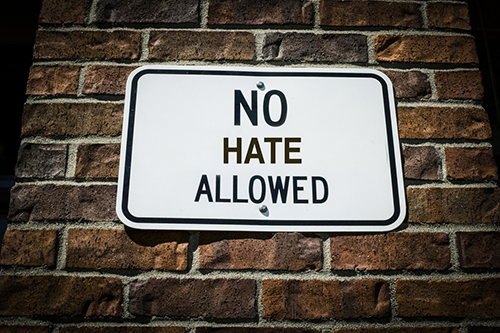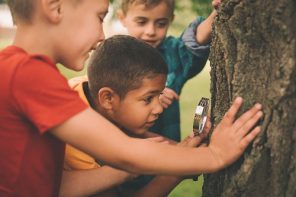It’s often said that children learn by imitating others, especially those in positions of authority. And in this present culture of toxic shaming, trolling and name calling—by adults—it’s especially disheartening when we see our children act in a way that is hurtful to others.
As parents, we must use these moments as opportunities to teach and reinforce our cultural values of tolerance and kindness. That’s what Winston Churchill High School in Potomac, Md. did last school year after students distributed so-called “N-word passes,” which granted other students permission to use the racial slur.
The school responded quickly. The principal, Brandice C. Heckert, sent an email to parents denouncing the racist incident and reinforcing the school’s resolve to create a “welcoming and respectful climate for all.”
“The principal recognized the severity of the incident and also recognized the potential for disruption among students and families,” said attorney Bruce Adelson, PTSA president at Churchill, one of the top high schools in Montgomery County, Maryland.
That’s because earlier in the year swastikas were found at the school on two separate occasions and there were multiple hate incidents in the previous school year. Heckert and Adelson began working closely together to strategize ways to break the pattern of hate and bring their school community together.

5 Strategies to Help Kids Resolve Conflict
Help your kids become better at conflict resolution by teaching them empathy, and other conflict resolution techniques.
“I felt it was important to make an immediate, strong PTA statement of support for the school while also informing our community that this conduct is unacceptable at Churchill,” Adelson said.
Adelson talked with concerned parents and shared their desires with the school and district administrators. The PTSA then held an open forum—with school and district administrators present—to address what happened, hear from parents and students, and discuss next steps.
Following the forum, Adelson asked Heckert to include a curricular response to the hate incidents and N-word passes in English and social studies classes, which were implemented by the school. He then invited an expert on implicit bias and building cultural competencies to share lessons with the school community, which includes immigrant students and their families—many of whom do not understand the history of racism in America.
“Open discussion and dialogue about tolerance and bias are vitally significant. Understanding and awareness, without blame or accusation, are best achieved through informed, thoughtful dialogue,” said Adelson, who teaches implicit bias and cultural awareness at Georgetown University Medical School.
“Not everyone is on the same page about what is intolerant, biased conduct and what must be unacceptable in our schools.”
Adelson felt that with the increase in hate and bias incidents in their county and nationally, more needed to be done. He met with the school district director to discuss how the district could better address these issues and create permanent change.
Through his advocacy, the district now has a multi-step plan for hate incidents in schools. Adelson was named the 2018-2019 Montgomery County PTA President of the Year for his efforts.
Communication with the School Community: Your Response is Key
“Too often incidents occur, and students and parents don’t know what to do, who to go to, or what to expect in response,” said Lynne Harris, president of Montgomery County Council of PTAs (MCCPTA).
“We work hard to push the school system to have transparent, accessible and reliable systems and resources for reporting, following up and addressing incidents of all types—to ensure that our school communities know what to do, and what to expect, when bad things happen.”
MCCPTA uses Adelson and Heckert’s constructive response to the incidents at Churchill as an example of what to do during a crisis. Harris said she is extraordinarily proud of the work the MCCPTA School Climate and Safety Chair, Gillian Huebner, has done to partner with the Montgomery County school system to respond to difficult issues in schools.
When there is a bias incident in one of their schools, one of Huebner’s best practices for leaders is to feed the facts, not the fears. She sends parent leaders and other members an email to summarize what happened, provides links to any news reports and reporting protocols, and includes helpful resources.
“We also work with partner organizations and agencies to host events and forums on specific areas such as mental wellness, LGBTQIA issues, and the opportunity gap, and share resources with our local PTAs to help them learn best practices around positive school climates,” said Harris.
“We want to ensure our school system seeks out, and truly hears, the student perspective on all decisions made.”
Here are three MCCPTA-recommended anti-bias resources:
No Place for Hate helps schools incorporate ADL’s anti-bias and anti-bullying resources within their existing programming to form one powerful message that all students have a place to belong.
Teaching Tolerance provides free resources to teachers, administrators and counselors to supplement their curriculum to encourage young people to challenge prejudice and learn how to be change agents in their lives.
Owning Up Curriculum teaches young people to understand their individual development in relation to group behavior, the influence of social media on their conflicts and the dynamics that lead to discrimination and bigotry.
Ask the Expert
We asked Bruce Adelson two questions to help PTAs be ready to confront a bias/hate incident if one should occur in their school community:
How can a school help prevent bias/hate incidents from happening (if possible)?
- Effective, meaningful school personnel education about bias and tolerance, conducted by external experts.
- School curriculum, beginning in elementary school, that addresses racism and tolerance.
- Clear, unequivocal school district consequences for hate incidents, including…
- Permanent record inclusion, ensuring colleges will be informed, which motivates parents/students to recognize the seriousness of such conduct
- Public service options with tolerance/bias ramifications for offenders
What are the top things a PTA should do to address a hate/ bias incident and create a welcoming and inclusive school environment?
- Ensure that addressing (not avoiding or minimizing) bias and hate issues are priorities in your school and school district.
- Make sure PTAs are open to tolerance and bias discussions.
- Require that hate/bias incidents are immediately reported and dealt with effectively.
- Send an unequivocal, powerful message that bias and hate are NOT welcome in our school and will result in serious consequences.
Kisha D. Lester is the senior editorial and digital manager at National PTA.





